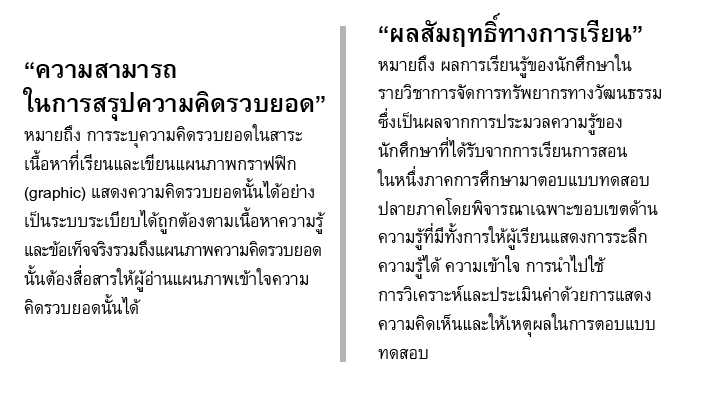
การวิจัยในชั้นเรียน : การศึกษาความสัมพันธ์ระหว่างความสามารถในการสรุป ความคิดรวบยอดกับผลสัมฤทธิ์ทางการเรียนของนักศึกษา
CLASSROOM ACTION RESEARCH: A STUDY OF THE RELATIONSHIP BETWEEN CONCEPTUALIZATION CAPABILITIES AND STUDENTS’ LEARNING ACHIEVEMENTS
โดย สันถวี นิยมทรัพย์ / By Santhawee Niyomsap, Thanik Lertcharnrit
Damrong Journal, Vol 11, No.1, 2012
บทคัดย่อ:
การวิจัยครั้งนี้เป็นการหาความสัมพันธ์ระหว่างความสามารถในการสรุปความคิดรวบยอดกับผลสัมฤทธิ์ทางการเรียนของนักศึกษา และค้นหาเทคนิคการสอนที่เหมาะสมในการพัฒนาความคิดรวบยอดของผู้เรียน โดยทำการวิจัยกับนักศึกษาระดับปริญญาตรี คณะโบราณคดี มหาวิทยาลัยศิลปากรที่ลงทะเบียนเรียนรายวิชาการจัดการทรัพยากรวัฒนธรรม ภาคการศึกษาต้น ปีการศึกษา 2554 จำนวน 36 คน เก็บข้อมูลภายหลังจากที่นักศึกษาผ่านการเรียนครบทุกหัวข้อแล้วให้เขียนแผนภาพสรุปความคิดรวบยอด เรื่องการจัดการทรัพยากรวัฒนธรรม และสอบปลายภาคด้วยข้อสอบอัตนัยตามลำดับ แล้วนำคะแนนการเขียนแผนภาพสรุปความคิดรวบยอดและคะแนนสอบปลายภาคมาหาค่าสัมประสิทธิ์สหสัมพันธ์จากสูตรสหสัมพันธ์ของเพียร์สัน (Pearson product-moment coefficient correla¬tion) และทดสอบนัยสำคัญของค่าสหสัมพันธ์ด้วยการทดสอบที (t-test) ด้วยโปรแกรมประมวลผลทางสถิติ ผลการวิจัยพบว่าคะแนนแผนภาพความคิดรวบยอดกับคะแนนสอบปลายภาคของนักศึกษามีความสัมพันธ์ในทิศทางเดียวกันในระดับปานกลาง (r=0.56) นั่นคือความสามารถในการสรุปความคิดรวบยอดสาระเนื้อหาวิชาการจัดการทรัพยากรวัฒนธรรมกับผลสัมฤทธิ์ทางการเรียนของนักศึกษามีความสัมพันธ์กันทางบวกอย่างมีนัยสำคัญทางสถิติที่ระดับ .01 ดังนั้นผู้สอนควรวางแผนการสอนโดยนำเทคนิคการใช้แผนภาพสรุปความคิดรวบยอดของนักศึกษาไปใช้จัดการเรียนการสอนและพัฒนากระบวนการเรียนรู้ของผู้เรียนในโอกาสต่อไป
ABSTRACT:
This research seeks to identify the relationship between conceptualization capabilities and learning achievements among students, and to discover appropriate teaching techniques for the development of learners’ conceptualizations. The research was conducted with36 undergraduate students at the Faculty of Archaeology, Silpakorn University, who were enrolled in the class “Cultural Resource Management” in the first semester of the 2011 academic year. Data were collected after students had completed the class. Data were based on two areas: 1) concept maps of cultural resource management drawn by students; 2) the final exam. Scores given to the concept maps and final exam scores were analyzed using the Pearson product-moment coefficient correlation program, and the significance was tested using the t-test statistics program. It was found that there is a moderate correlation (r = 0.56) between concept map scores and final exam scores. That is, the capability in the conceptualizations of the subject content and learning achievements are positively correlated, with the statistical significance rated at 0.1. It is, therefore, suggested that instructors should include concept map techniques in the teaching and development of their student learning process.











